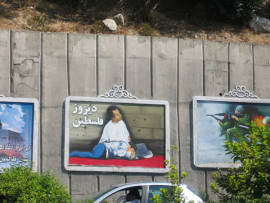
Ryan Bishop: Total War and Total Images, or the Blind Originary Event of Peace
Total war, much as described through Negar’s quotations of a former US marine, entails a targeting of citizens. The rationale, as we all know, runs along the lines of the following: if every segment of a given society is mobilized in a war effort, as was the case during WWII and the Cold War, then any aspect of that society is a legitimate target for attack. During the British air raids on Germany, the strategy was called “dehousing the work force,” a nice euphemism for civilian targeting. The role of targets in urbanization and militarization, which cannot be separated from the movement of neoliberal markets and the deployment of information tele-technologies, is something that I have spent a good bit of time working on with my colleagues and friends Greg Clancey and John Phillips (as Under Fire 2 exhibited through Jordan’s kind auspices).
Negar’s evocation of images of the veils in relation to Reading Lolita in Tehran foregrounds the veil’s manifest polyvalence, or perhaps just good old fashioned double bind (as in, either veiled or unveiled, the women in countries that don veils somehow embody the stakes of long standing struggles regardless of their own desires). Within a specific representative regime, the veil is the target. I am reminded of the long reach of this targeting, a parabolic arc that takes us back to Homer’s Iliad. The word for veil and battlement in the ancient Greek are the same, so when Andromache stands on the city’s walls to see her husband’s body defiled in death being dragged through the dirt beyond the city gates, she removes her veil, letting it fall from her head and body, signifying the fall of the city walls as well. Both she and the city are undone. In a moment of terrible beauty, Homer brings the veil and battlement together, both as target. Both reveal the profound paradox of security. Only that which is valuable is protected, and that very protection draws attention – it attracts through the act of providing security. The defense itself is a lure. Defense and security undo themselves through their very enacting.
The veil has long become a target. Perhaps now, in an age of network-base warfare and total global surveillance, the screen functions rather a lot like a veil: a target of total war by total images.
The veil. The screen. The image. The target. Veils, screens, images, targets.
Nestled between prefix and suffix, the word veil resides in the very heart of the word surveillance. Though the etymologies of the terms come to English in largely unrelated ways, the role of covering and uncovering in surveillance is key to its operation, as well as to its self-defeating deployment. But perhaps more to the point, with the veil, we return to the question of epistemology and violence, for the veil and unveiling relate to truth as aeltheia, or truth as ongoing unconcealment. In the veil, as in the screen and the image, we find the material and immaterial means of thinking through the epistemology of violence. But I do not think we will find the means for engaging critically with epistemological parameters in them, nor am I convinced they exist in experimental art, though I wish they did. However, the latency mentioned by Wolfgang does adhere with a delay or lag that is found in the effects of the most powerful avant-garde art work of the early 20th century, much of which we find manifesting itself in contemporary military technology. One could not have predicted these effects at the time. We had to wait for the century to unfold, to reveal itself. So perhaps Wolfgang is looking in the right place. However, if there is a power in latency, in delay, in lag, in effect, then we will not and cannot foresee what the outcomes will be. If we can see that which will become the originary event of peace now, then that will not be the event later. It will have been veiled from the outset; we will have been blinded to it.

